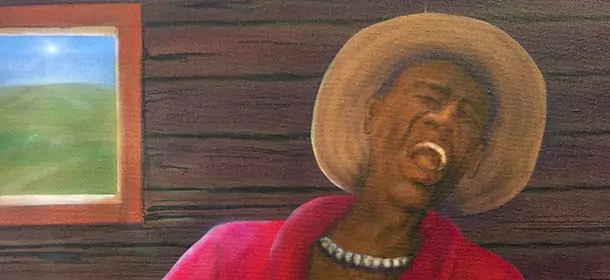

The airbrush is a tool that we associate with makeup and photo retouching — but it can be used for fine art, too, as Fritz DesRoches’ paintings prove. This month’s solo artist has been using the airbrush for decades, and he wrote this guest blog post to share what he’s learned about it.
About the author: Fritz DesRoches was born in Port-au-Prince, Haiti and grew up in Boston. After 20 years in the US Army, he retired and stayed in Germany for nearly 30 years. In February 2013, he returned to the US. He is a member of the Torpedo Factory Artists Association and The Art League. His solo exhibit, “The Caribbean — How Beautiful,” is on view at The Art League Gallery through Sunday, April 3.

Since my childhood, as far as I can remember, I have always liked art. I have always found a way to draw or paint something, whether it was a face, a landscape, seascape, or any human shape in that nature. I love photorealism, as shown in my paintings.
I love the airbrush better than the brush because of the smooth transition of the paint to the canvas.
I first started with the airbrush in the early seventies. I purchased a small Badger airbrush kit, including a compressor, and found later that kit was for hobby painting. Well, I had fun with it. It wasn’t until 1989 when a friend introduced me to the real “art of the air” airbrush paintings. It was then I saw what one can achieve with the airbrush, and I fell in love with this instrument right away. I love the airbrush better than the brush because of the smooth transition of the paint to the canvas.

The airbrush is not an easy instrument to master. Once you have a good understanding of its usage, I believe realism close to perfect can be achieved. I paint on canvases, which is much harder to airbrush on. It requires a thicker paint that will not run on the canvas. The .3mm nozzle on my airbrush fits that purpose, it allows the paint to flow freely, but with one major obstacle: clogging.
Clogging is the airbrusher’s nightmare. It destroys the mood, the concentration and everything. If not properly approached, it can destroy an expensive airbrush. One must know how to fix this problem and this is where patience plays an important role in airbrushing. So far, I can’t find anything in the market that can prevent clogging.

For over 25 years, I have been using the airbrush intensively. With hard work, tenacity, a never-give-up attitude, I self-taught in airbrush techniques. It was a matter of practice and “learn as you go.” I now feel very comfortable that I can airbrush any photo to any surface with minimal help from the shield or masking. My style is unique; it depicts the everyday lifestyle of the Caribbean people, mainly of Haiti.
— Fritz DesRoches

Sign up for our weekly blog newsletter, subscribe to our RSS feed, or like us on Facebook for the latest Art League news. Visit our homepage for more information about our classes, exhibits, and events in Old Town Alexandria, Virginia.
You can support The Art League every time you shop through AmazonSmile!
Simply set The Art League as your chosen charity, and every time you shop at smile.amazon.com, a portion of your purchase will be donated to support our mission to share the experience of visual arts with the community.